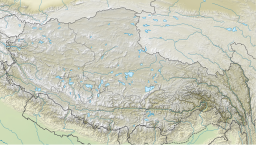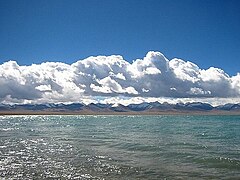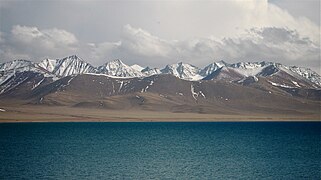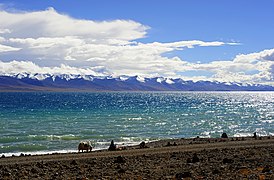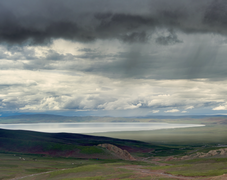Namtso
| Namtso / Namco | |
|---|---|
 View of the lake and the holy rock near theTashi Dormonastery (2005) | |
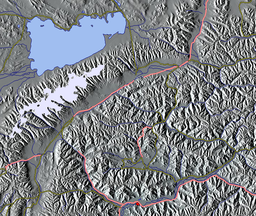 Relief map. Lhasa is the area marked in red at the bottom. | |
| Location | Damxung/Baingoin,Tibet Autonomous Region |
| Coordinates | 30°42′N90°33′E/ 30.700°N 90.550°E |
| Type | salt lake |
| Primary inflows | snow cover and spring of Tanggula Mountains |
| Primary outflows | None (endorheic)[1] |
| Basincountries | People's Republic of China |
| Max. length | 70 km (43 mi) |
| Max. width | 30 km (19 mi) |
| Surface area | 1,920 km2(740 sq mi) |
| Average depth | 33 m (108 ft) |
| Max. depth | 125 m (410 ft)[2] |
| Water volume | 768 billion cubic metres (623×106acre⋅ft) |
| Surface elevation | 4,718 m (15,479 ft) |
| Islands | 5 |
| Namtso | |||||||||||
| Tibetanname | |||||||||||
|---|---|---|---|---|---|---|---|---|---|---|---|
| Tibetan | གནམ་མཚོ་ | ||||||||||
| |||||||||||
| Chinesename | |||||||||||
| Traditional Chinese | Nạp mộc thác | ||||||||||
| Simplified Chinese | Nạp mộc thác | ||||||||||
| |||||||||||
NamtsoorLake Nam(officially:Namco;Mongolian:Tenger nuur;Chinese:Nạp mộc thác;pinyin:Nàmù Cuò;Tibetan:གནམ་མཚོ་,ZYPY:Nam Co;“Heavenly Lake” in European literature:Tengri Nor,30°42′N90°33′E/ 30.700°N 90.550°E) is a mountain lake on the border betweenDamxung CountyofLhasa prefecture-level cityandBaingoin CountyofNagqu Prefecturein theTibet Autonomous RegionofChina,approximately 112 kilometres (70 mi) NNW ofLhasa.
Geography[edit]
Namtso (Namco) is a lake that first formed during thePaleogeneage, as a result of Himalayan tectonic plate movements. The lake lies at an elevation of 4,718 m (15,479 ft), and has a surface area of 1,900 km2(730 sq mi).[3]Thissalt lakeis the largestlakein theTibet Autonomous Region.However, it is not the largest lake on theQinghai-Tibet Plateau.That title belongs toQinghai Lake(more than twice the size of Namtso); which lies more than 1,000 km (620 mi) to the north-east inQinghai.
Namtso has five uninhabited islands of reasonable size, in addition to one or two rocky outcrops. The islands have been used for spiritual retreat by pilgrims who walk over the lake's frozen surface at the end of winter, carrying their food with them. They spend the summer there, unable to return to shore again until the water freezes the following winter. This practice is no longer permitted by Chinese authorities.[citation needed]
The largest of the islands is in the northwest corner of the lake, and is about 2,100 m (6,900 ft) long and 800 m (2,600 ft) wide, rising to just over 100 m (330 ft) in the middle. At its closest point it is about 3.1 km (1.9 mi) from the shore.[citation needed]
Climate[edit]
The weather at Namtso is subject to abrupt, sudden change and snowstorms are very common across the Nyainqêntanglha range.[citation needed]
Namtso has aKöppen climate classificationofalpineortundra climate(Koppen ET).[citation needed]
| Climate data for Namtso (Namco) | |||||||||||||
|---|---|---|---|---|---|---|---|---|---|---|---|---|---|
| Month | Jan | Feb | Mar | Apr | May | Jun | Jul | Aug | Sep | Oct | Nov | Dec | Year |
| Mean daily maximum °C (°F) | −3.0 (26.6) |
−1.4 (29.5) |
1.7 (35.1) |
5.6 (42.1) |
10.0 (50.0) |
14.0 (57.2) |
14.4 (57.9) |
13.4 (56.1) |
11.7 (53.1) |
6.5 (43.7) |
1.4 (34.5) |
−1.7 (28.9) |
6.1 (42.9) |
| Daily mean °C (°F) | −11.8 (10.8) |
−9.6 (14.7) |
−6.1 (21.0) |
−1.7 (28.9) |
2.9 (37.2) |
7.3 (45.1) |
8.4 (47.1) |
7.7 (45.9) |
5.6 (42.1) |
−0.3 (31.5) |
−6.8 (19.8) |
−10.5 (13.1) |
−1.2 (29.8) |
| Mean daily minimum °C (°F) | −20.6 (−5.1) |
−17.8 (0.0) |
−13.8 (7.2) |
−9.0 (15.8) |
−4.2 (24.4) |
0.7 (33.3) |
2.5 (36.5) |
2.1 (35.8) |
−0.4 (31.3) |
−7.1 (19.2) |
−14.9 (5.2) |
−19.3 (−2.7) |
−8.5 (16.7) |
| Averageprecipitationmm (inches) | 1 (0.0) |
1 (0.0) |
1 (0.0) |
4 (0.2) |
14 (0.6) |
51 (2.0) |
87 (3.4) |
87 (3.4) |
48 (1.9) |
10 (0.4) |
2 (0.1) |
1 (0.0) |
307 (12) |
| Source:"NAMTSO QU Climate (China)".Climate-Data.org. | |||||||||||||
Other Features[edit]

Namtso is renowned as one of the most beautiful places in theNyainqêntanglhamountain range. Its cavehermitageshave for centuries been the destination of Tibetanpilgrims.A surfaced road acrossLaken Passat 5186 m was completed to the lake in 2005, enabling easy access fromLhasaand the development of tourism at the lake. Settlements in the area includeDobjoi,DonggarandCha'gyungoinba.TheTashi Dormonastery is located at the southeastern corner of the lake.
Around the area's natural elements, historical and anthropological background, a 2010 romantic dramaChinese:Hương cách lí lạpShangri-La,starring China's popular actorHu Ge,was broadcast at CCTV1 and received positive reviews.[4]Some scenes in the 2002 Hong Kong filmThe Touchwere filmed at the lake. Namtso Lake was featured in Episode 4,The Roof of the World,of BBC TV series:Himalaya with Michael Palin.
Gallery[edit]
|
Asteroid[edit]
Asteroid248388 Namtso,discovered by Italian astronomerVincenzo Casulliin 2005, was named after the lake.[5]The officialnaming citationwas published by theMinor Planet Centeron 5 October 2017 (M.P.C.106504).[6]
See also[edit]
- Gomang Co
- Kanas Lake
- Lake Urru
- Laken Pass(Lakenla)
- Siling Lake
References[edit]
- ^Schütt, Brigitta; Berking, Jonas; Frechen, Manfred; Yi, Chaolu (September 2008).Late Pleistocene Lake Level Fluctuations of the Nam Co, Tibetan Plateau, China(PDF).Vol. 52. pp. 57–74.Bibcode:2008ZGmS...52...57S.doi:10.1127/0372-8854/2008/0052S2-0057.
{{cite book}}:|work=ignored (help) - ^"Chinese, German scientists record new depth of Nam Co Lake".Archived fromthe originalon December 3, 2010.
- ^"Namtso Lake".Universities Space Research Association.October 5, 2004.
- ^"Hồ ca chủ diễn 《 hương cách lí lạp 》30 phân chung phiến hoa - điện thị kịch 《 hương cách lí lạp 》_ tân lãng thị tần"[Hu Ge starring in "Shangri-La" 30 minutes- TV series "Shangri-La" _Sina video]. SINA Corporation.
- ^"248388 Namtso (2005 SE19)".Minor Planet Center.RetrievedJuly 21,2019.
- ^"MPC/MPO/MPS Archive".Minor Planet Center.RetrievedJuly 21,2019.

